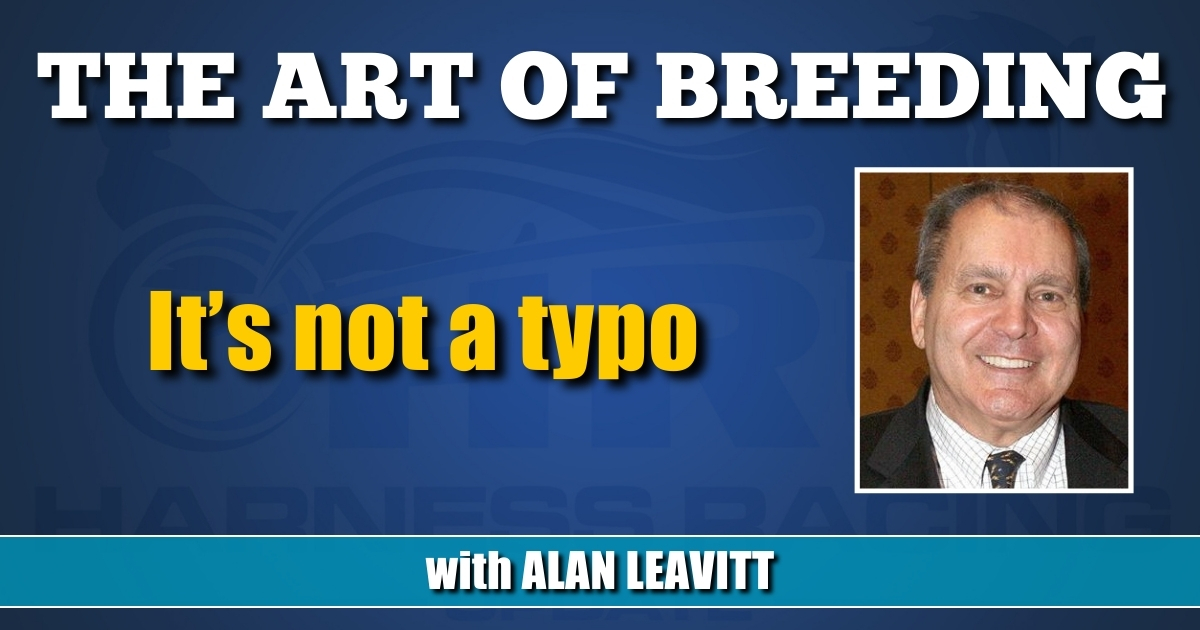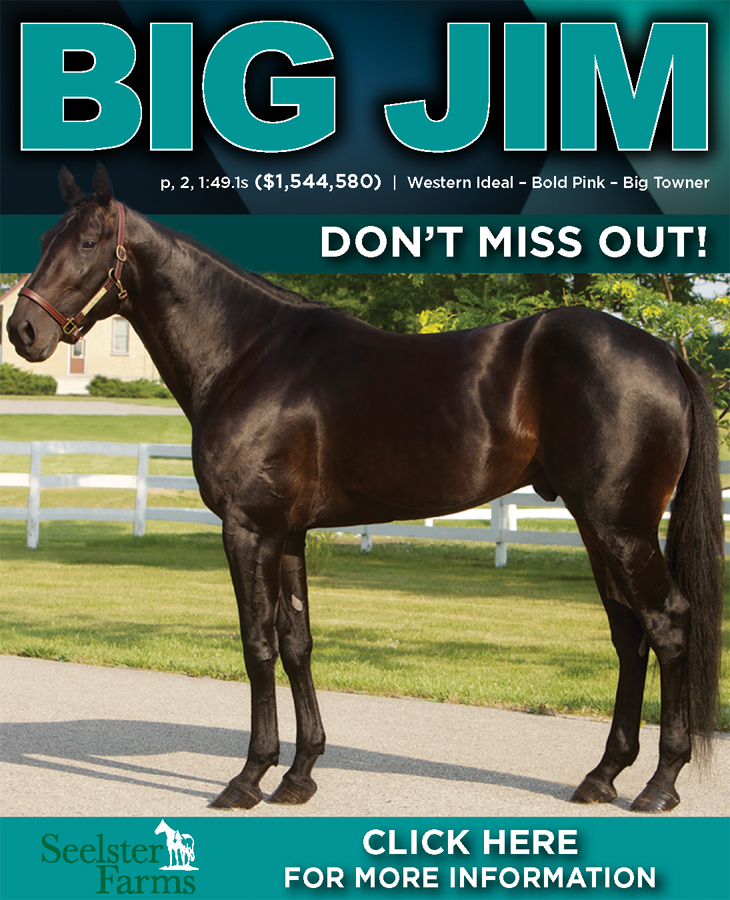

It’s not a typo
by Alan Leavitt
Interesting pedigrees don’t grow on trees, but unusual ones are getting so rare you can almost think of them as unicorns. That’s because the breeding of the American standardbred has become so refined that it now follows pre-ordained paths, especially when it comes to the breeding of the two separate gaits, the trot and the pace.
So this kid, at first glance, thought it must be because of some typos that a 2-year-old trotter named Golden Wall AS was listed as by Walner and out of Golden Door Lindy, by Cambest.
It has been an article of faith that the pace is always the superior gait to the trot when you breed one gait to the other. Down through the years there have been numerous experiments in which one gait is bred to the other, and the result, unfailingly, has been a slow pacer.
However, there were no typos regarding Golden Wall AS’s sire and dam. He’s definitely by Walner, and out of Golden Door Lindy, who’s by Cambest. His second dam, Special Soul, is by Artsplace. But then his Tail-Mare line takes a 180 degree turn, and from his third dam on back to Methuselah it’s solid trotting blood, and excellent trotting blood at that. But, it’s really too far back to be influential. We’ll get to that, though, shortly (which, to any pedants out there, is the opposite of “longly”).
The appearance of Cambest touches a particular nerve of mine. We had just started Walnut Hall Ltd. when Cambest time-trialed in 1:46.1, making him the fastest standardbred of all time. And, for the record, he kept that distinction for the next 21 years.
Cambest was owned by Danny Kramer and trained by Fred Grant. Freddie was then, and still is today, one of the best trainers who ever threw a line over a horse. As fate would have it, Cambest went from Springfield, where he went against the fence, to the Delaware, Ohio race meeting. The big attraction there was the Little Brown Jug. There was also a race for older pacers, the Senior Jug, and Cambest won it.
However, somewhere along the line there was a blood test with a primitive blood gas meter. It came out high. Needless to say, it caused quite a furor. And as you might have already guessed, the fact that the machine was soon found to be fatally flawed was totally left out of the equation that condemned Cambest and his record.
The plot continued to thicken, when the Hanover Shoe Farms announced immediately after Cambest took his record that he’d be standing at Hanover, starting with the next breeding season. Then came the high blood gas meter reading at Delaware, and suddenly Cambest was back out on the street. One of the contributing factors to his rejection was a series of phone calls to the Hanover office in which people asked if this was the right number for Dairy Queen.
At this point enter this kid, stage left. At dinner in town with Ronnie Gurfein and Myron Bell, the whole Cambest caper, as we say in the detective trade, was laid out in all its details.
Rushing home, I woke Geoff Stein to get Danny Kramer’s home phone number. It wasn’t an easy sell, but the bottom line, or if you prefer another cliché, at the end of the day, Cambest came to stand here at Walnut Hall Ltd.
Cambest was probably very close to being the perfect pacing stallion. He had a wonderful, chiseled head, with big, full, beautiful eyes, and sharp little ears that hooked in perfectly. His body was exactly what you would expect from a world class performer, and his coat was naturally a glistening brown that just glowed in the sun. I’d say more, but I don’t want to start using superlatives.
His world record mile was one thing, but his potential as a sire was better defined, at least to me, by the 12 races he won at 2. You may remember that for me and my Italian pal, Federico Tesio, brilliance on the racetrack at 2 was and still is the best indicator of a stallion’s future sire potential.
It clearly was true for Cambest, because at one time his progeny were three of the four fastest pacers in the four major categories. He was blessed with a genotype, his genetic makeup, that clearly was a stacked genetic deck. He moved up virtually every mare to whom he was bred, and if she just met him halfway genetically, the result was a very fast, successful pacer.
So there you have the sire of the dam of Golden Wall AS. Just to put him into perspective, he’s made three starts to date, and won two of them. In his one loss, he made a break leaving, caught back trotting and made up a lot of ground to still finish fourth. In his last start, he won off by himself in 1:54.4. Not earth shaking, but showing enough to make you wonder, how high is up?
For the record, he was bred and is still owned by ACL Stuteri, and is trained by the indefatigable Anette Lorentzen.
That brings us to Walner, the sire of Golden Wall AS. By all rights, any trotter bred to a mare by Cambest, out of a mare by Artsplace, should produce a pacer. Yet here it didn’t.
One can only conclude that Walner must himself have a genetic card deck that holds only top value cards. How else to explain how he could produce a trotter, against all that strong pacing blood, and a good trotter at that?
If you ever have a reason to read the Detective’s Manual, you’ll see that the first rule is this: There is no such thing as coincidence. I fully subscribe to the maxim, and it certainly applies here, to Golden Wall AS. It is no accident that Walner has sired a good trotter here, against all odds. As a sire, he is a loaded shotgun, and as we all know, a loaded shotgun is dangerous in anyone’s hands.
Maybe partly as an escape these days, I find myself remembering happier times from my long ago teenage years at the horse shows. One that still stands out was when I was 14. The show was at Elmira, NY, barely a wide place in the road, but for whatever reason it put on a good show, and all the good stables were there.
At the time there were two top-five gaited stallions who battled it out every week on the show circuit, and naturally they were both at Elmira. One of them, named Genius Firefly, was ridden by a native Kentuckian, Owen Haley. The other stud, King of Revelry, also had a transplanted Kentuckian trainer, Wendell Jones.
But once you got past the Kentucky part, there was no similarity. Owen was the original Kentucky gentleman, a polite, soft spoken model of good manners and decorum. Wendell Jones was at the other end of the scale. He was gregarious, with a gift for mimicry so you could hear several different voices in any story he told, and a drinker.
So, in they came on their two studs on the first night for the stallion and gelding class. It had rained for most of that day, and there were puddles actually standing on the ring’s tanbark. Despite the heavy going, they were both flying at the rack and the trot.
Everything was fine the first way of the ring, but then the judge told them to reverse and trot. Going around a turn, Wendell had all his weight on his inside leg, when his inside stirrup slipped off the stirrup hook, and he came crashing down into a huge puddle.
I’d never seen anything like that before, but somehow it occurred to me that if you fell off, you’d be disqualified. But that wasn’t the way it happened. Wendell’s horse was caught, his stirrup was replaced, and he got back on and finished the class. And the judge tied him first.
Owen was clearly incensed, and although he kept his voice low and spoke politely, he informed the judge that he’d never show another horse in front of him.
There was an open, outside bar on the grounds, and for the next two days, Wendell Jones was its best customer. And at frequent intervals he informed all within earshot that he could fall off, get back on, and still beat Owen Haley. Which quickly got back to Owen, who was skulking in his tack room.
So the show concluded with the five gaited stake, which was no contest for Wendell and King of Revelry. But after he’d won the big stake, Wendell discovered that he’d lost his wallet.
So he knew exactly what to do. He found his fellow Kentuckian, Owen Haley, and explained his plight and the long and short of it was, Owen lent him $200 to get home on.
I can’t say there were giants in those days, but there were definitely some who were larger than life.















